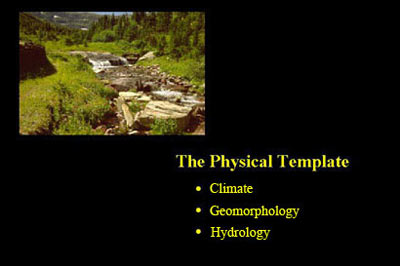The Physical Template
Within the watershed, various forms of matter, including water, are in constant cyclic flow. Through these processes, an abiotic (non-living) template of air, water, and soil is formed, upon which life can exist. The physical template of watershed structure is ultimately determined by varying combinations of climatic, geomorphic, and hydrologic processes.
Climatology, the science of climate and its causes, becomes important in understanding regional issues in watershed science. Though sometimes used synonymously with weather, climate is actually a distinct term with important ecological ramifications. Climate refers to an aggregate of both average and extreme conditions of temperature, humidity, and precipitation (including type and amount), winds, and cloud cover, measured over an extended period of time. Weather refers to present-day environmental conditions; current temperatures and meteorological events make up weather, not climate. Long-term weather trends establish averages which become climatic regimes. Climate heavily influences watershed vegetation communities, streamflow magnitude and timing, water temperature, and many other key watershed characteristics.
Geology is defined as the science centered around the study of various earth structures, processes, compositions, characteristics, and histories. Geomorphology, however, refers specifically to the study of the landforms on the earth and the processes that change them over time. Fluvial geomorphology, referring to structure and dynamics of stream and river corridors, is especially important to understanding the formation and alteration of the stream or river channel as well as the flood plain and associated upland transitional zone; this is a critical discipline for effective, long-term watershed management.
One of the life-sustaining cycles we are most familiar with is the hydrologic cycle. This cycle is a natural, solar-driven process of evaporation, condensation, precipitation, and runoff.
Hydrology is the science of water, as it relates to the hydrologic cycle. More specifically, it is the science of water in all its forms (liquid, gas, and solid) on, in and over the land areas of the earth, including its distribution, circulation and behavior, its chemical and physical properties, together with the reaction of the environment (including all living things) on water itself. The global water budget adds further insight into the water resources of our planet.
![[logo] US EPA](https://www.epa.gov/epafiles/images/logo_epaseal.gif)
